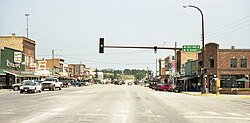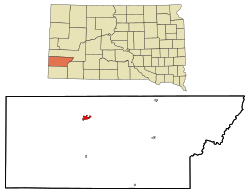Custer, South Dakota
| Custer | |
|---|---|
| City | |
| Custer, South Dakota | |

The main street in 2003
|
|
 Location in Custer County and the state of South Dakota |
|
| Coordinates: 43°46′6″N 103°35′51″W / 43.76833°N 103.59750°WCoordinates: 43°46′6″N 103°35′51″W / 43.76833°N 103.59750°W | |
| Country | United States |
| State | South Dakota |
| County | Custer |
| Founded | 1875 |
| Area | |
| • Total | 2.54 sq mi (6.58 km2) |
| • Land | 2.53 sq mi (6.55 km2) |
| • Water | 0.01 sq mi (0.03 km2) |
| Elevation | 5,315 ft (1,620 m) |
| Population (2010) | |
| • Total | 1,987 |
| • Estimate (2015) | 1,952 |
| • Density | 817.0/sq mi (315.4/km2) |
| Time zone | MST (UTC-7) |
| • Summer (DST) | MDT (UTC-6) |
| Zip Code | 57730 |
| Area code(s) | 605 |
| FIPS code | 46-15140 |
| GNIS feature ID | 1265633 |
| Website | City of Custer |
Custer is a city in Custer County, South Dakota, United States. The population was 1987 at the 2010 census. It is the county seat of Custer County.
Custer is generally considered to be the oldest town established by European Americans in the Black Hills of South Dakota and Wyoming. Gold was found there during the 1874 Black Hills Expedition, conducted by the 7th Cavalry led by Lt. Colonel George Armstrong Custer, a discovery which initiated the Black Hills Gold Rush.
For thousands of years, the Black Hills had been part of the territory of varying tribes of indigenous peoples. They were within historical territory of the Oglala Sioux at the time of United States encounter, and within the Great Sioux Reservation established by the US Treaty of Fort Laramie (1868). Having established dominance in the area by the eighteenth century, the Oglala Sioux had long considered the Black Hills as sacred land.
After increasing encroachment by European Americans and violent confrontations, the U.S. government forced the Sioux to cede much of the Black Hills in 1877, and opened the land for individual purchase and settlement. In 1875 trespassing gold-boomers named their settlement Stonewall (after the Confederate general, Stonewall Jackson), but it was renamed for Custer. Almost abandoned in 1876 after word of the much larger gold strikes in Deadwood Gulch spread, Custer later became an established city.
Custer has had a smaller population and been less wealthy than the Northern Hills cities of Deadwood and Lead. In addition to gold, Custer and other cities based their economies on the extraction of industrial minerals, which are still important to the regional economy. Custer claims to have the widest Main Street in the United States. The city made the street wide enough in the nineteenth century for a team of oxen pulling a wagon to turn completely around.
...
Wikipedia
